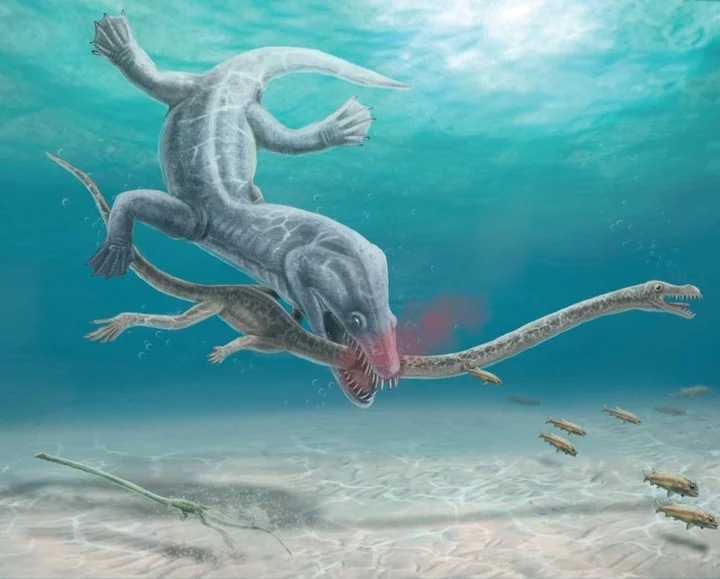By Will Dunham
WASHINGTON In shallow waters about 242 million years ago, a strange marine reptile built unlike any other animal ever on Earth hunted for fish and squid, using an inordinately elongated neck to ambush prey. Suddenly and violently, its life ended - decapitated by a powerful predator.
Scientists for two centuries have suspected that prehistoric marine reptiles like this one, named Tanystropheus, possessing very long necks were highly vulnerable to such attacks. A fresh examination of Tanystropheus fossils unearthed in Switzerland decades ago on a mountain called Monte San Giorgio has provided the first unambiguous evidence to demonstrate it.
The researchers studied neck and head remains of two species of Tanystropheus, detecting bite marks and other signs of trauma indicating decapitation. The larger species, the one that ate fish and squid, reached 20 feet (6 meters) long, though this individual was about 13 feet (4 meters). The smaller species was about 5 feet (1.5 meters) long, with teeth indicating a diet of soft-shelled invertebrates like shrimp.
The neck of Tanystropheus was three times longer than its torso. Useful in hunting, extreme neck elongation was common among marine reptiles spanning about 175 million years during the age of dinosaurs. But this came with a price: an obvious weak spot for predation.
There was evidence of predation in the fossils of both species. One has two tooth-shaped punctures and a tooth scratch. The other has a pit caused by a tooth hitting the bone. Both bear bone injuries where the neck was severed.
"These very dramatic examples of predator-prey interaction are extremely rare in fossils, and they give us an insight into how these animals lived together. It reminds us that these creatures went through dramatic events similar to what we see in nature today - in this case in a particularly vivid and gruesome way," said paleontologist Stephan Spiekman of the State Museum of Natural History Stuttgart in Germany, lead author of the research published this week in the journal Current Biology.
The attacker of the bigger Tanystropheus species likely was a large marine reptile, the researchers said, perhaps a species of: Cymbospondylus, 33 feet (10 meters) long; Nothosaurus, 23 feet (7 meters) long; or Helveticosaurus, 12 feet (3.5 meters) long.
Various marine reptiles or predatory fish, they said, could have decapitated the smaller species.
Tanystropheus, appearing during the Triassic Period at a time of evolutionary innovation following Earth's worst mass extinction, thrived across the northern hemisphere for 10 million years. It was a distant relative of the dinosaurs, which first appeared roughly 230 million years ago.
"We think Tanystropheus spent most of its time in the water, staying in the shallows, using its small head and long neck to ambush prey from the sea floor," Spiekman said.
Its neck was composed of 13 elongated vertebrae, almost cylindrical and hollow. Despite a marine existence, Tanystropheus lacked certain swimming adaptations, with limbs resembling lizards or crocodiles rather than flippers and no tail fluke. Its wide skull had upward-facing nostrils like modern crocs.
"Tanystropheus is so interesting because its body plan is entirely unique in the history of all of life. Sure, there are other animals with a very long neck, but not a neck that is this long, this stiff and this lightweight, with very long, string-like neck ribs. And then what adds to the weirdness and mystery is that the rest of the animal is also puzzling," Spiekman said.
It shows how evolution can be a game of trade-offs.
"The long-necked reptile might not realize that it is being attacked until it is too late, especially if the predator comes from its back and thus the small head is very far away. All in all, long-necked marine reptiles were able to overcome this weak spot, likely because the long neck had more advantages," said State Museum of Natural History Stuttgart paleontologist and study co-author Eudald Mujal.
(Reporting by Will Dunham, Editing by Rosalba O'Brien)

